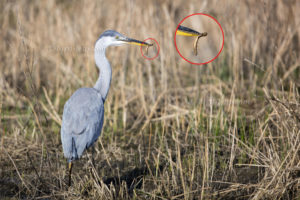 The Grey Heron (Ardea cinerea) flies elegantly on the wetland in the middle of the agricultural landscape of the Lower (Niederer) Fläming. Carefully the bird secures to all sides before it starts on the muddy shore with the search for food. Although at the beginning it just stands silently on the edge and obviously lets the whole scenery work on it in contemplation. For a long time, I look at the Grey Heron and its feeding site from a hide. Then I return my eyes to the lonely Green Sandpiper (Tringa ochropus), who has been scared off by the Grey Heron and is looking for food on the opposite bank. The wader gets then society in the form of a Common Snipe (Gallinago gallinago) as well.
The Grey Heron (Ardea cinerea) flies elegantly on the wetland in the middle of the agricultural landscape of the Lower (Niederer) Fläming. Carefully the bird secures to all sides before it starts on the muddy shore with the search for food. Although at the beginning it just stands silently on the edge and obviously lets the whole scenery work on it in contemplation. For a long time, I look at the Grey Heron and its feeding site from a hide. Then I return my eyes to the lonely Green Sandpiper (Tringa ochropus), who has been scared off by the Grey Heron and is looking for food on the opposite bank. The wader gets then society in the form of a Common Snipe (Gallinago gallinago) as well.
After a while, the Grey Heron apparently managed to convince himself of the lack of space. After some settling in, he walks along the shore; the other birds (the Common Snipe and the Green Sandpiper) are on the lookout. The proximity of the good 5 times as big heron is obviously suspect for them. Suddenly I hear a loud splash in the water. The Grey Heron has captured swimming a Smooth Newt (Lissotriton vulgaris). Smooth Newt, also known as the Common Newt is a species of amphibian, the most common one in Germany. The Heron brings the Smooth Newt ashore and chews extensively on the newt. I am surprised that the Grey Heron does not swallow the Smooth Newt directly down. But the Newt probably does not taste that well. At some point the Grey Heron leaves the Smooth Newt fall on the land and returns – clearly disgusted – back to the shore. There is a very clear beak of tearing and head-shaking testifies to the experience with the unappetizing booty. After a while the Grey Heron cannot leave the good piece of fresh meat. It grabs the Common Newt again and dips it again and again into the muddy water. Then the amphibian seems to have been cleaned so far that the Heron devours the bite with a short tearing of the beak.
I gladly used a 4.0 / 600 IS II on a Canon EOS 5 DsR for the sitting on sound-sensitive birds. The Canon 1 DX is simply too loud even in the so-called silent mode. With the EOS 5 DsR I can do without a 1.4 converter if it were necessary at the short distance. The 2x-Converter I need anyway only for documentary photos of very far away standing birds.
The Fläming is a glacially formed ridge and at the same time a historically grown cultural landscape in southwestern Brandenburg and eastern Saxony-Anhalt. For the Niedere Fläming is a barren extensive farmland typical. The whole Fläming is a 30 to 50 kilometers wide ridge, which extends east of Magdeburg over more than 100 kilometers to the Dahme river. The Fläming was formed especially in the Saale ice age. The Fläming owes its formation to the repeated advances of the Scandinavian inland ice and is therefore built up for the most part of glacial sediments
The name of the sparsely populated derived from the Flaemings (Flemings), who populated the area in german colonization in high numbers in the middle ages. For centuries, the Fläming border area was divided between the Archdiocese of Magdeburg, the diocese of Brandenburg, the county Brehna and the Margraviate of Meissen, the future Electorate of Saxony. In 1815, after the French and Saxon defeat, the entire Fläming was incorporated into the Kingdom of Prussia.
Due to the diversity of the glacial deposits in the Fläming, the resulting soil communities are very heterogeneous. Their profitability ranges from extremely nutrient-poor and barren to very fertile.
The most fertile soils can be found in the so-called Sandlössgürtel between Bad Belzig and Dahme (town). On maps and satellite photos, this area stands out as a strikingly forest-free strip because of its agricultural use. These soils are well supplied with nutrients and easy to work with, but they can be wetted, especially in sediment bedding. The Fläming lies, like the surrounding regions, in the transition area from the oceanic climate of Western Europe to the continental climate of Eastern Europe. The climatic differences to its surroundings are small, however, clearly felt in certain weather conditions.
To cope with the growing demand for top shots of the rarer species of the Palearctic Bird-Lens is keen to enrich the range of pictures of birds you can find in the western Palearctic. Trips to remote places to capture images not only of rare birds of western Palearctic were very successful. The nice image of the blog is only a first impression, what you will find in the gallery in the “Picture Shop” very soon. Just give bird-lens.com a message, if bird-lens.com could serve you with an image needed before the new pictures are online.